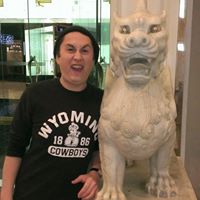David L Iverson
age ~52
from Tacoma, WA
- Also known as:
-
- David L Teat
David Iverson Phones & Addresses
- Tacoma, WA
- Lakewood, WA
Work
-
Company:A cooks tour
-
Address:221 214Th Ave Ne, Redmond, WA 98074
-
Phones:(425)5579905
-
Position:Owner
-
Industries:Tour Operators
License Records
David M Iverson
License #:
9866 - Expired
Category:
Electricians
Issued Date:
Jul 27, 1994
Expiration Date:
Jun 30, 2008
Type:
Electrician Journeyman
David M Iverson
License #:
9866 - Expired
Category:
Electricians
Issued Date:
Jul 27, 1994
Expiration Date:
Jun 30, 2008
Type:
Electrician Journeyman
David K. Iverson
License #:
05755 - Expired
Category:
Contractor
Expiration Date:
May 31, 2013
David Thomas Iverson
License #:
331 - Expired
Category:
Environmental Hlth Specialist
Issued Date:
Dec 30, 1998
Effective Date:
Dec 1, 2008
Expiration Date:
Dec 31, 2008
Type:
Environmental Health Specialist
Name / Title
Company / Classification
Phones & Addresses
Owner
A Cooks Tour
Tour Operators
Tour Operators
221 214Th Ave Ne, Redmond, WA 98074
Website: acookstour.com
Website: acookstour.com
President
Liberty Associates
Operators of Nonresidential Buildings
Operators of Nonresidential Buildings
1809 7Th Ave Ste 1710, Seattle, WA 98101
Controller
Cargo Transport Inc
Water Transportation of Freight
Water Transportation of Freight
6700 W Marginal Way Sw, Seattle, WA 98106
President
Liberty Associates
Lessors of Nonresidential Buildings (except Miniwarehouses)
Lessors of Nonresidential Buildings (except Miniwarehouses)
1809 7 Ave, Seattle, WA 98101
(206)6223312
(206)6223312
Director, Treasurer
Dfw Dama
President
Broadcast Ink
Internet · Entertainment Services, Namely Broadcasting Sports Events On Radio · Radio Broadcasting
Internet · Entertainment Services, Namely Broadcasting Sports Events On Radio · Radio Broadcasting
1809 7 Ave #1710, Seattle, WA 98101
(206)6219140
(206)6219140
Unknown Historic
RAM OF ALASKA L.L.C
10013 59 SW, Lakewood, WA 98499
59TH STREET LAND COMPANY, LLC
108 Country Clb Dr SW, Lakewood, WA 98498
Us Patents
-
Inductively Heatable Fluid Reservoir For Various Fluid Types
view source -
US Patent:20160228897, Aug 11, 2016
-
Filed:Oct 8, 2015
-
Appl. No.:14/879014
-
Inventors:- Seattle WA, US
David Oscar Iverson - Seattle WA, US
Garet Glenn Nenninger - Seattle WA, US
Roland David Horth - Seattle WA, US -
International Classification:B05B 11/00
B05B 11/04
H05B 6/10
B05B 11/02 -
Abstract:In various embodiments, a fluid delivery pod includes a first surface, a second surface that opposes the first surface, a reservoir body, an outlet port, a heating structure, and a valve assembly. The reservoir body is between the first and the second surfaces. The reservoir body is configured to house a fluid. The outlet port is positioned on a surface of the pod. The surface is between the first and the second surfaces. The heating structure is thermally coupled to the fluid housed within the reservoir body. The heating structure wirelessly receives energy from an energy source that is external to the fluid delivery pod. The wirelessly received energy heats the fluid housed within the reservoir body. In response to an application of compression forces on the first and the second surfaces, the valve assembly dispenses the heated fluid through the outlet port and out of the fluid delivery pod.
-
Portable Fluid Warming Device
view source -
US Patent:20160234887, Aug 11, 2016
-
Filed:Oct 8, 2015
-
Appl. No.:14/878984
-
Inventors:- Seattle WA, US
David Oscar Iverson - Seattle WA, US
Garet Glenn Nenninger - Seattle WA, US
Roland David Horth - Seattle WA, US -
International Classification:H05B 6/10
B05B 11/00
B05B 11/04
H05B 3/00
H05B 6/06 -
Abstract:A portable device heats a fluid within a reservoir. The device includes a housing, a cavity, and an energizing element. The housing includes a first longitudinal end, a second longitudinal end, and outer surfaces of the device. The outer surfaces extend from an outer portion of the first longitudinal end to an outer portion of the second longitudinal end. The cavity extends from a cavity port that is positioned on an inner portion of the first longitudinal end to a cavity terminal positioned intermediate the first and second longitudinal ends. Inner lateral surfaces are adjacent the cavity and extend from the inner portion of the first longitudinal end to an outer portion of the cavity terminal. The energizing element is around the cavity. The cavity is positioned intermediate a first energizing element portion and a second energizing element portion. The energizing element provides energy to the cavity.
-
Inductively Heatable Fluid Reservoir
view source -
US Patent:20150273513, Oct 1, 2015
-
Filed:Oct 31, 2014
-
Appl. No.:14/530479
-
Inventors:Amy Carol Buckalter - Seattle WA, US
David Oscar Iverson - Tacoma WA, US
Garet Glenn Nenninger - Seattle WA, US
Roland David Horth - Seattle WA, US
Jonathan B. Hadley - Renton WA, US -
International Classification:B05C 5/00
-
Abstract:A fluid reservoir includes a reservoir body, a heating structure, a piston, and an outlet port. The reservoir body includes a cross section, and a translation axis. The cross section is uniform along the translation axis. When fluid is housed in the reservoir, the heating structure is thermally coupled to the fluid. The heating structure energizes the fluid housed in the reservoir. The piston translates along the translation axis. An available volume of the reservoir to house the fluid is defined by a distance between the piston and an end of the reservoir body. When the piston is translated along the translation axis toward the end, a volume of the fluid that has been energized by the heating structure flows from the reservoir and through the outlet port. The volume of energized fluid is linearly proportional to a length of the translation of the piston.
-
Automatic Heated Fluid Dispenser
view source -
US Patent:20150265107, Sep 24, 2015
-
Filed:Oct 31, 2014
-
Appl. No.:14/530447
-
Inventors:Amy Carol Buckalter - Seattle WA, US
David Oscar Iverson - Tacoma WA, US
Garet Glenn Nenninger - Seattle WA, US
Roland David Horth - Seattle WA, US
Jonathan B. Hadley - Renton WA, US -
International Classification:A47K 5/12
B67D 3/00 -
Abstract:A dispenser includes a housing, an aperture, a receptacle, a heating element, and an actuator. When a reservoir is received within the receptacle, an outlet port of the reservoir is exposed through the aperture. The heating element heats fluid housed within the reservoir. The actuator provides a dispensing force that induces a flow of the heated fluid. In some embodiments, the heater is an inductive heater. In other embodiments, the heater is a resistive heater. The dispenser dispenses the fluid through the aperture. Another embodiment of a dispenser may include a housing, an aperture, a receptacle within the housing, an actuator configured to receive a fluid reservoir, and a power source. The power source provides power to the actuator. The power source includes an alternating current source.
Resumes

Electrical Engineer
view sourceLocation:
900 east Pine St, Seattle, WA 98122
Industry:
Medical Devices
Work:
Pensar Development
Electrical Engineer
Mirabilis Medica 2007 - 2009
Electrical Engineer
Liposonix/Medicis Feb 2005 - Jun 2007
Electrical Engineer
Cascad Engineering Service Dec 2003 - Feb 2005
Contract Electrical Engineer
Electrical Engineer
Mirabilis Medica 2007 - 2009
Electrical Engineer
Liposonix/Medicis Feb 2005 - Jun 2007
Electrical Engineer
Cascad Engineering Service Dec 2003 - Feb 2005
Contract Electrical Engineer
Education:
Cedarville University 2000 - 2003
Bachelors, Bachelor of Science In Electrical Engineering, Electrical Engineering Eatonville High School 1998
Bachelors, Bachelor of Science In Electrical Engineering, Electrical Engineering Eatonville High School 1998
Skills:
Engineering
Electrical Engineering
Pcb Design
Research and Development
Engineering Management
R&D
Design For Manufacturing
Product Development
Medical Devices
Manufacturing
Electrical Engineering
Pcb Design
Research and Development
Engineering Management
R&D
Design For Manufacturing
Product Development
Medical Devices
Manufacturing

Strategic Account Manager
view sourceLocation:
Seattle, WA
Industry:
Restaurants
Work:
Prestige Worldwide
Strategic Account Manager
Ram International
Manager
Strategic Account Manager
Ram International
Manager
Skills:
Restaurant Management
Team Building
Hospitality
Restaurants
Menu Development
Catering
Fine Dining
Food and Beverage
Food
Culinary Skills
Inventory Management
Food Service
P&L
Team Building
Hospitality
Restaurants
Menu Development
Catering
Fine Dining
Food and Beverage
Food
Culinary Skills
Inventory Management
Food Service
P&L

David Iverson
view source
David Iverson
view sourceWork:
David Iverson
Freelance Art Director and Graphic Designer
Freelance Art Director and Graphic Designer

David Iverson
view sourceLocation:
United States

David Iverson
view sourceLocation:
United States

David Iverson
view sourceLocation:
United States

David Iverson
view sourceLocation:
United States
Youtube
Myspace
Plaxo

David Iverson
view sourceFlickr

David Iverson
view source
David Iverson
view source
David Iverson
view source
David Jay Iverson
view source
David Iverson
view source
David Iverson
view source
David A Iverson
view source
David Iverson
view sourceGoogleplus

David Iverson
Work:
White House Mortgages - Dominion Lending Centres - Mortgage Professional
About:
David Iverson, AMPMortgage ProfessionalWhite House Mortgages - Dominion Lending Centres 250-878-1541

David Iverson

David Iverson

David Iverson

David Iverson

David Iverson

David Iverson
Lived:
Maple Valley, WA
Renton, WA
Kent, WA
Milton, WA
Renton, WA
Kent, WA
Milton, WA
Work:
The Driver Training Goup, Inc - Controller
VMC Consulting, Inc.
VMC Consulting, Inc.
Education:
Central Washington University

David Iverson
Work:
Retired
None
None
Classmates

David Iverson
view sourceSchools:
Watford City High School Watford City ND 1962-1966
Community:
Tj Jerde, Borge Fisketjon, Bruce Erickson

David Iverson
view sourceSchools:
Glenwood High School Glenwood MN 1985-1989
Community:
Sherri Bergquist, Neil Tangen, Sheryl Baughman

David Benjamin (Iverson)
view sourceSchools:
Covenant Christian High School Cranford NJ 1999-2002
Community:
Kathleen Cejnowski, John Broman

David Iverson
view sourceSchools:
St. Bride School Chicago IL 1956-1964
Community:
Sandra Hubl, Yvetta Williams, Janice Koch

David Iverson
view sourceSchools:
Mt. Blue High School Farmington ME 1982-1986
Community:
Joyce Reeves

David Iverson
view sourceSchools:
Rosemount High School Rosemount MN 1981-1985
Community:
Tracey Quigley, Teena Maki, Bob Sacamano, Laura Geere, Sharon Lyman, Suzanne Hase, Kimmi Hayhurst, Dale Otto, Alan Haffa, Brad Dieringer, Angela Lester

David Iverson
view sourceSchools:
Wilson High School St. Paul MN 1957-1961
Community:
Connie Bursell, Charlotte Wachs, Dale Charboneau, Gayle Hepola, Sandra Bourn, Linda Larson, Robert Bailey, Lynn Carley, Darlene Kelm, Dick Nelson, Kenton Oberg, Terri Wallace

David Iverson
view sourceSchools:
St. Anthony School Renton WA 1974-1981
Community:
Sonya Reilly, Barbara Morris, Christy Hofferber, Michelle Bryant
Get Report for David L Iverson from Tacoma, WA, age ~52



















